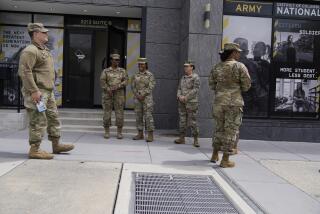Army plans to cut length of combat tours
- Share via
WASHINGTON — Moving to relieve strain on troops, the Army plans to reduce the length of combat tours from 15 months to one year after the troop buildup in Iraq winds down this summer, top officials told Congress on Tuesday.
Gen. George W. Casey Jr., the Army chief of staff, said he would trim combat tours once the Pentagon fulfilled plans to reduce the number of Army brigades in Iraq by July.
Also Tuesday, the Senate resumed debate on the war, taking up a measure by Sen. Russell D. Feingold (D-Wis.), a leading war critic, to compel a troop withdrawal and to restrict funding to more limited missions in Iraq, including training Iraqi forces and mounting limited counter-terrorism operations.
After President Bush ordered the “surge” in U.S. combat forces last year, Defense Secretary Robert M. Gates extended combat tours from the standard 12 months to 15 months. The extensions were considered necessary to ensure that there would be enough troops available to support the buildup.
But the extensions have resulted in strains on military families. Though combat tours now are longer, active-duty Army personnel are still given only 12 months at their home base between deployments.
In December, U.S. officials began removing troops sent as part of the buildup. When the last of those extra troops are withdrawn in July, Gen. David H. Petraeus, the top American commander in Iraq, has said he would seek to delay further troop cuts in order to solidify recent security gains.
Sen. Carl M. Levin (D-Mich.), chairman of the Senate Armed Services Committee, asked whether Casey would be able to cut the length of tours even if troop withdrawals did not continue.
“If Gen. Petraeus is able to execute the announced plan of getting to 15 brigades by July, it would be our goal at that point to return to 12 months versus 15 months,” Casey said.
Casey reiterated long-standing concerns among Army commanders about the long and repeated tours of duty.
“The cumulative effects of the last six-plus years at war have left our Army out of balance, consumed by the current fight and unable to do the things we know we need to do,” Casey said.
But even as the Army cuts the length of combat tours, other demanding measures will remain in place. Army Secretary Pete Geren said the Army would probably have to continue its so-called stop-loss policy, which forces soldiers to remain in the Army beyond their enlistment period if their unit is about to deploy to Iraq.
About 8,000 soldiers are currently prohibited from leaving under the policy. Geren said that number could drop to 7,000, but would not go much lower before October.
Casey hopes to gradually increase the amount of time soldiers have between tours in order to allow the Army to better train forces for a range of threats, not just the counterinsurgency tactics being used in Iraq.
In the Senate, Feingold’s bill stands no chance of overcoming Republican opposition, much like similar legislation last year.
In any case, the White House has threatened a veto.
But Tuesday, GOP lawmakers made a tactical decision to allow further debate of the measure. Senate Minority Leader Mitch McConnell (R-Ky.) said he welcomed the opportunity to discuss progress in Iraq.
The measure cleared a procedural hurdle, 70 to 24, with 45 Republicans joining 24 antiwar Democrats and one antiwar independent voting to proceed to debate the bill. Opposition came mostly from centrist Democrats.
Presidential candidates Hillary Rodham Clinton (D-N.Y.), John McCain (R-Ariz.) and Barack Obama (D-Ill.) missed the vote. A final vote on the proposal could occur this week or next.
--
noam.levey@latimes.com
More to Read
Get the L.A. Times Politics newsletter
Deeply reported insights into legislation, politics and policy from Sacramento, Washington and beyond. In your inbox twice per week.
You may occasionally receive promotional content from the Los Angeles Times.











